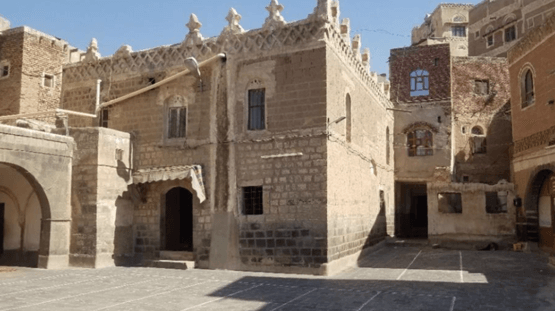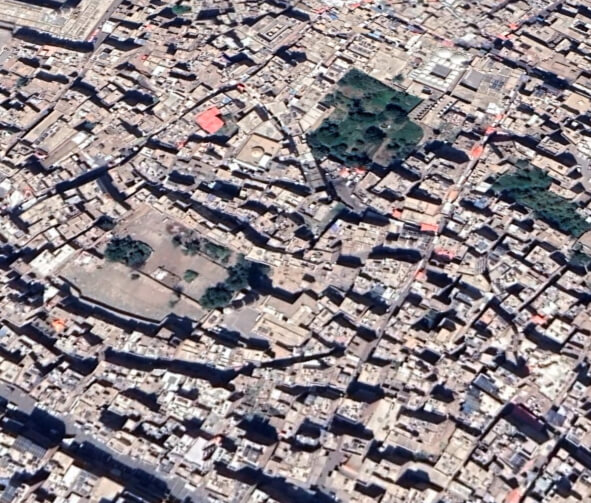
Mūsā Mosque – Old Ṣan‘ā’
مسجد موسى – صنعاء القديم ة
Monument description
Musa Mosque is one of the Mosques located on the southeast side of Old Sana‘a. Two entrances on the southern side lead inside the Mosque: the first on the western side leads to a covered hall, and from the northern side the entrance leads directly to the southern courtyard of the Mosque. The second entrance is on the east side. An arched entrance (with a semicircular arch) leads to a covered hall connected by a corridor. It is exposed parallel to the eastern and northern walls of the Prayer Hall and ends with a wide entrance that leads to the entrances to the altars. The entrance from this hall to the eastern entrance to the courtyard is a wide entrance with arches. The corridor ends with a two-tiered thick wooden door. This entrance leads to a small roofed vestibule open from the west side to the courtyard of the west vestibule. The Qibla wall parallels the Matahir building which is bounded on the west by the penthouse and western courtyard, and on the south by a courtyard and the women’s Mosque.

Architectural and cultural value
Construction style and built date: The design style of the Prayer Hall follows the rectangular building style, with a flat roof supported by a series of vaulted bays. The foundation of the Musa Mosque dates back to the 8th century AH (14th century CE). The founder of the Mosque is Musa bin Al-Makan during the era of the state of Bani Rasul, an era that witnessed the flourishing of religious institutions. However, the power struggle between the different authorities, caused the destruction of a number of cultural monuments, such as the Musa Mosque, subjected to demolition. The Mosque could have been forgotten had it not been for the efforts of charities during the 12th century AH / 18th century CE.
Components of the Mosque: It consists of the Prayer Hall (Bantian), the courtyard, the shed, the Minaret, a modern Mosque for women, the Ablution Units, divided bathrooms, a small cemetery, the house of values and the house of the Imam. The monument area is 1150 m².
- Justifications for intervention:
- 1. The building has been neglected for lack of funding
2. Preserving the monument and preventing further damage
3. Restoration of damages to the Mosque resulting from the air strikes to the northern part of the Old City of Sana‘a.
4. Contribute to the restoration of damaged monuments in a proper manner in order to keep Old Sa-na‘a in the World Heritage List.
- Monument conditions:
- The historical Monument is generally in good conditions, but there are some clear signs of damage that need urgent intervention:
Seriuos damages
1. Increased humidity on the walls and foundations with moisture and rain
2. Salinity and erosion of the gutter in the western wall
3. Presence of deformations on the external walls such as cement
4. The base of the Minaret needs special maintenance in view of its height. Obvious signs of damage of the Minaret are the collapse of bricks and the impact of the solid plaster niches that adorn the building
5. Corrosion of mortars on the purification basins built with sawn stone with a layer of abrasives
6. Wear and tear of bricks in most parts of the Mosque annexes
7. Cracks and damages of the external pool parts.
- Treatment:
- 1. Renovation of the foundations and walls damaged by moisture due to rain
- 2. Elimination of the causes of the moisture
- 3. Restoration of the gutter in the western wall and removal of the cemented part
- 4. Removing the cement deformations that occur on the external walls, and replacing it with Qudad
- 5. Restoration of the damaged areas in the Minaret using the old style
- 6. The short walls of septic tanks built with sawn stone should be covered with Qudad
- 7. Rehabilitation of antiseptics using the old style
- 8. Maintaining a symbolic element in the old lighting system, instead of using it as a storehouse for the Mosque’s waste and tools, and building a special shop outside the Mosque.

Countries










